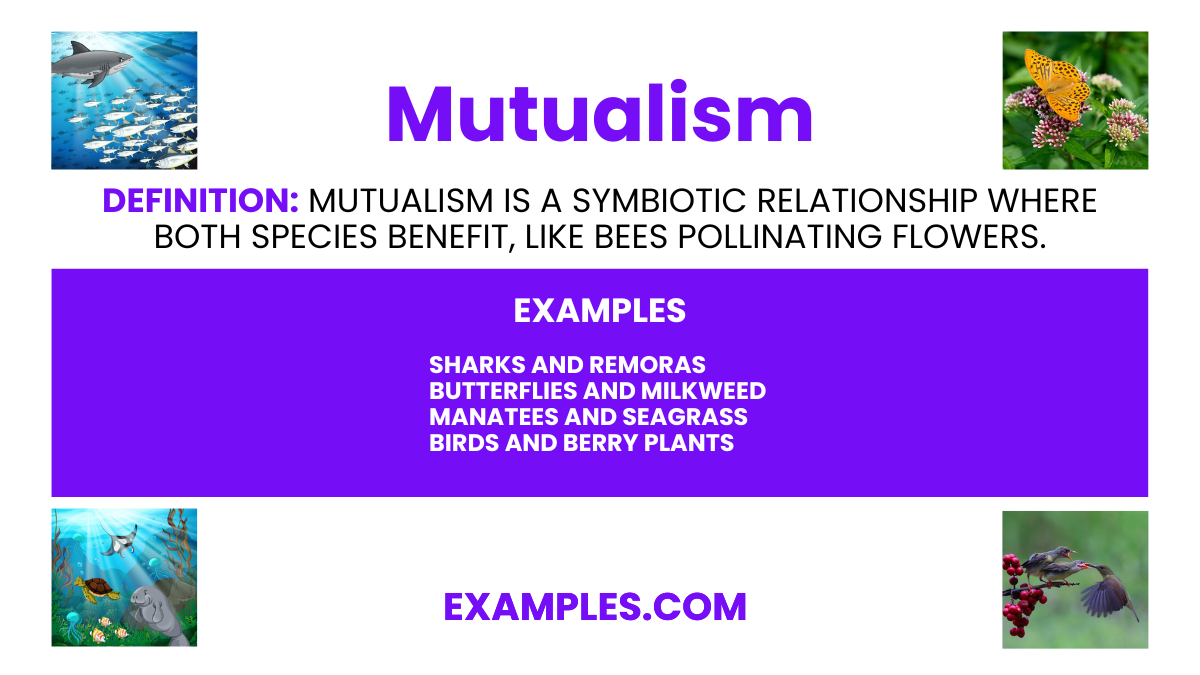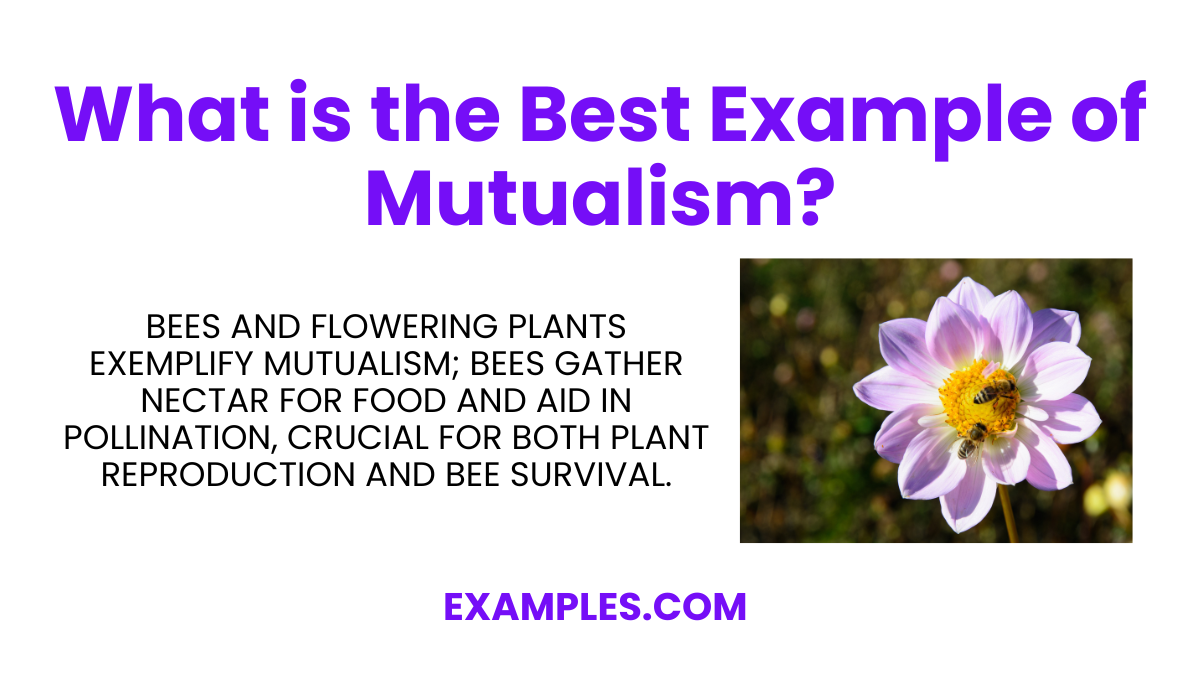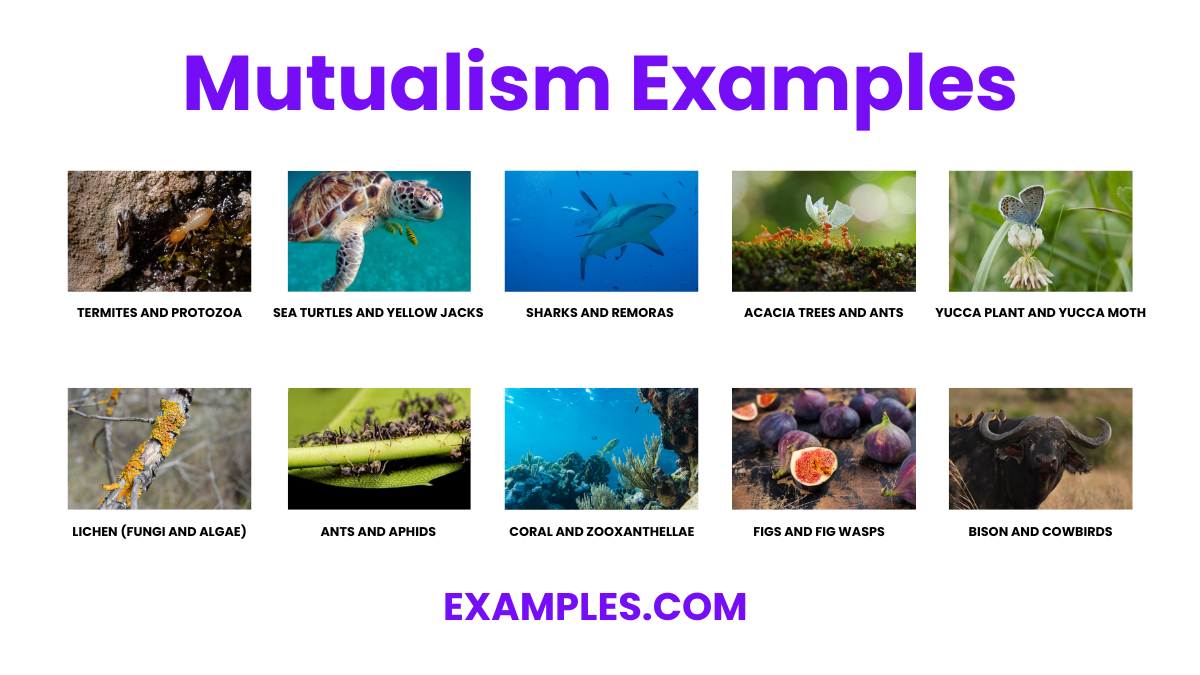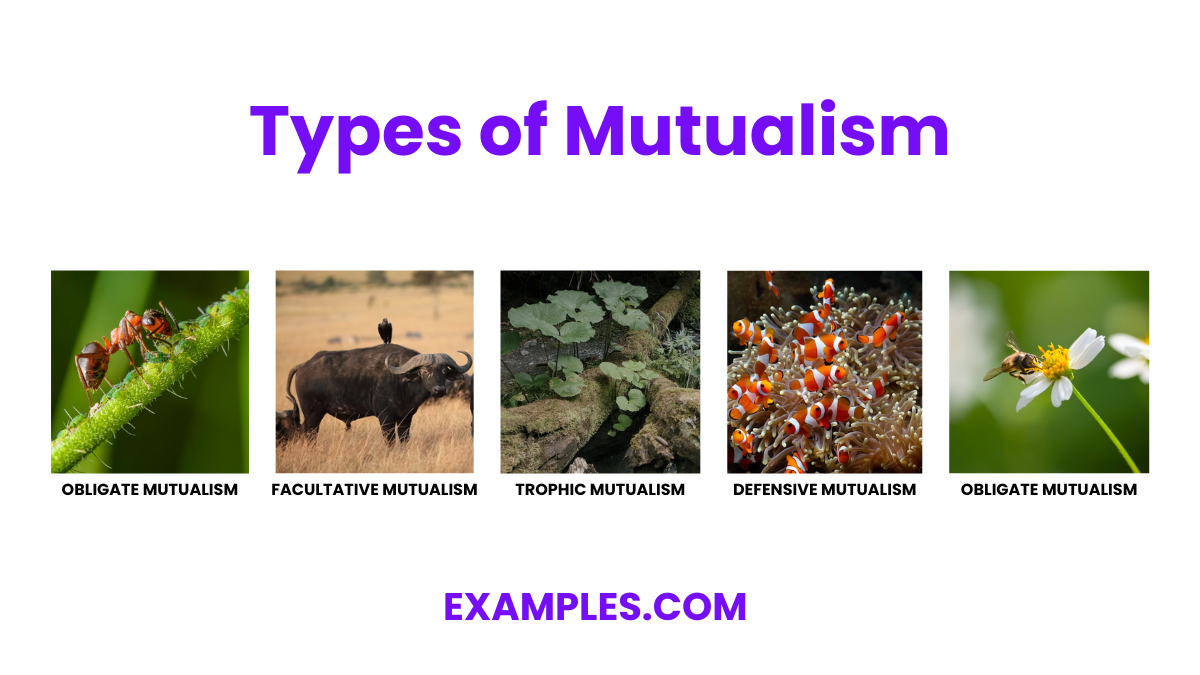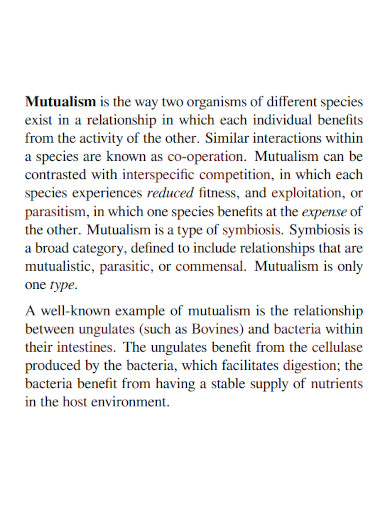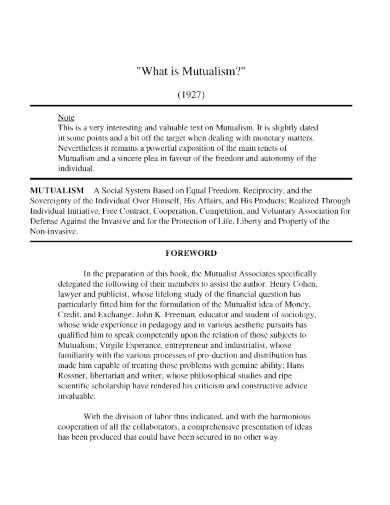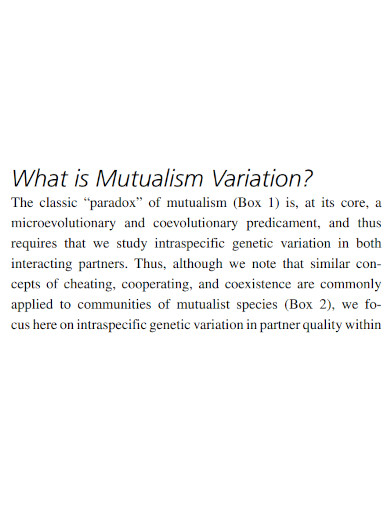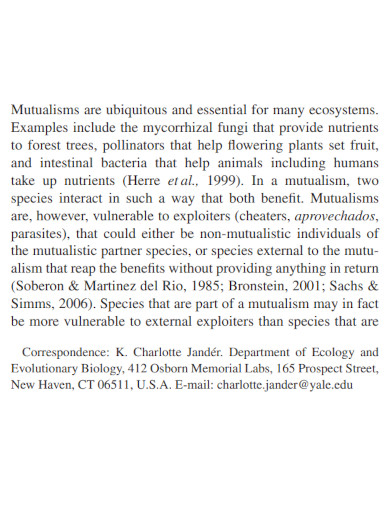Mutualism
Mutualism is a significant ecological interaction, involves two different species mutually benefiting from their relationship. This guide offers a deep dive into mutualism, providing teachers and students with clear, illustrative examples. We cover various mutualistic relationships, explaining how these interactions contribute to biodiversity and ecosystem health. From pollination by bees to the symbiosis in coral reefs, this guide enriches understanding of mutualism, making it accessible and engaging for educational purposes
What is Mutualism?
Mutualism is defined as the positive relationship between two similar or different types of organisms found in nature. Both of these organisms will have positive interactions with one another and will work together for the benefit of both organisms, which will lead to various coevolution, mutations, and adaptations. These do not only include wild animals, but they will also include the social mutualism found in the everyday lives of humans. There are even mutualistic interactions between plants, bacteria cultures, archaebacteria, and viruses.
What is the Best Example of Mutualism?
A classic example of mutualism is the relationship between bees and flowering plants. Bees collect nectar for food from flowers, while simultaneously helping plants with pollination. This interaction is vital for plant reproduction and the survival of bee populations, demonstrating a perfect mutualistic relationship.
Symbol of Mutualism
The symbol of mutualism in ecology is often represented by the image of a yin-yang. This symbol, originating from Chinese philosophy, depicts two halves that together complete a whole, symbolizing the balance and interdependence of forces. In the context of mutualism, it represents two different species that are interconnected and benefit each other, maintaining ecological balance. This symbol effectively captures the essence of mutualistic relationships, where each organism contributes to and benefits from the partnership, similar to the harmonious and complementary nature of the yin-yang.
20 Mutualism Examples
Mutualism is a fascinating aspect of ecology, where two species benefit mutually from their interaction. This concept is essential for teaching about ecosystems and biodiversity. The following 20 examples of mutualism provide a diverse look at how different species coexist and support each other. These examples are not only informative for students but also offer real-world insights into the importance of ecological balance. Each example is a testament to the intricate and cooperative relationships that exist in nature.
- Bees and Flowers: Bees get nectar from flowers, aiding in pollination.
- Clownfish and Sea Anemones: Clownfish get protection, anemones get cleaning.
- Oxpeckers and Large Mammals: Birds eat parasites off mammals’ skin.
- Lichen (Fungi and Algae): Algae provide food, fungi offer shelter.
- Root Nodules and Nitrogen-Fixing Bacteria: Bacteria fix nitrogen, plants provide carbohydrates.
- Ants and Aphids: Ants protect aphids, aphids provide honeydew.
- Coral and Zooxanthellae: Algae provide oxygen and nutrients, coral offers protection.
- Humans and Gut Microbiota: Bacteria aid digestion, humans provide habitat.
- Figs and Fig Wasps: Wasps pollinate, figs provide breeding ground.
- Mycorrhizal Fungi and Trees: Fungi enhance nutrient uptake, trees provide sugars.
- Sharks and Remoras: Remoras clean parasites, sharks offer transport.
- Goby Fish and Pistol Shrimp: Goby provides lookout, shrimp digs burrows.
- Yucca Plant and Yucca Moth: Moths pollinate, yucca hosts larvae.
- Acacia Trees and Ants: Ants protect acacia from herbivores, acacia provides nectar.
- Cleaner Fish and Host Fish: Cleaner fish eat parasites, host fish get cleaning.
- Termites and Protozoa: Protozoa digest cellulose, termites provide habitat.
- Bats and Agave Plants: Bats pollinate, agave provides nectar.
- Wolves and Ravens: Ravens scavenge wolf kills, wolves ignore them.
- Sea Turtles and Yellow Jacks: Jacks eat algae off turtles, turtles get cleaning.
- Bison and Cowbirds: Cowbirds eat insects stirred up by bison.
Types of Mutualism
Mutualism, a symbiotic relationship where both species benefit, can be categorized into various types, each with unique characteristics and examples.
- Obligate Mutualism: This type involves two species that are entirely dependent on each other for survival. An example is the relationship between certain ants and aphids. The ants protect the aphids from predators, and in return, the aphids provide a sweet substance called honeydew that the ants eat.
- Facultative Mutualism: In this type, the interaction is beneficial but not essential for the survival of either species. An example is the relationship between certain species of birds and large herbivores, like buffalo. The birds eat ticks and other parasites off the buffalo’s skin, getting food, while the buffalo benefits from the removal of these pests.
- Trophic Mutualism: This involves a mutualist relationship where one partner provides a resource in exchange for nutrients. A classic example is the mycorrhizal relationship between fungi and plants. The fungi facilitate the absorption of water and nutrients from the soil for the plant, while receiving carbohydrates produced by the plant through photosynthesis.
- Defensive Mutualism: This type involves one species providing a defense against predators or parasites in return for food or shelter. An example is the relationship between clownfish and sea anemones. The clownfish gains protection from predators by living among the anemone’s toxic tentacles, and it may provide nutrients to the anemone in the form of waste.
- Dispersive Mutualism: This occurs when one species aids in the dispersal of another’s seeds or pollen. A prime example is the relationship between bees and flowering plants. Bees collect nectar and pollen from flowers for food, and in the process, they help to pollinate the plants, aiding in their reproduction.
What is the Relationship of Mutualism
Mutualism is a symbiotic relationship where two different species closely interact, resulting in mutual benefits for both.
- Symbiotic Interaction: Mutualism is a symbiotic relationship where two different species closely interact and mutually benefit.
- Enhances Survival: Both species involved gain advantages essential for their survival and well-being.
- Example – Nitrogen-Fixing Bacteria and Legumes:
- Bacteria benefit by obtaining carbohydrates and a habitat.
- Plants gain by using the nitrogen converted by bacteria.
- Example – Insects and Flowering Plants:
- Insects like bees get nectar.
- Plants achieve pollination, crucial for reproduction.
- Ecosystem Health: Mutualism contributes to the stability and health of ecosystems.
Mutualism Vs Symbiosis
| Aspect | Mutualism | Symbiosis |
|---|---|---|
| Definition | A type of symbiotic relationship where both species involved benefit from the interaction. | A broad term that encompasses all types of close and long-term biological interactions between two different biological organisms. |
| Types of Interaction | Always beneficial to both parties involved. | Can be beneficial (mutualistic), harmful (parasitic), or neutral (commensalistic) to one or both parties. |
| Dependency | Often involves organisms that can survive independently, but thrive better together. | Includes relationships where one or both organisms cannot survive without the other (obligate) or can survive independently (facultative). |
| Examples | – Bees and flowering plants (pollination). <br> – Clownfish and sea anemones (protection and food). | – Mutualism: Lichens (algae and fungi). <br> – Parasitism: Tapeworms in the intestine of mammals. <br> – Commensalism: Barnacles on whales. |
Who Benefits in Mutualism
Mutualism is a type of symbiotic relationship where both organisms involved benefit from their interaction. This concept is vital for teachers to illustrate the interconnectedness of ecosystems to students. Here are eight examples, each with a one-line description, to clarify who benefits in mutualistic relationships:
- Bees and Flowers Bees get nectar for food from flowers, while flowers benefit from pollination as bees transfer pollen.
- Oxpeckers and Large Mammals Oxpeckers feed on ticks and parasites found on large mammals like buffaloes, providing relief to the mammals.
- Clownfish and Sea Anemones Clownfish gain protection from predators by living among the toxic tentacles of sea anemones, while anemones get food scraps from the clownfish.
- Humans and Gut Microbiota Humans benefit from the digestion and vitamin production of gut microbiota, while these microorganisms gain a suitable living environment.
- Lichens (Fungi and Algae) Algae conduct photosynthesis providing nutrients to fungi, while fungi offer protection and moisture to algae.
- Ants and Aphids Ants protect aphids from predators, and in return, aphids provide ants with honeydew, a sweet by-product of their diet.
- Coral and Zooxanthellae Algae Coral provides algae with a protected environment and compounds they need for photosynthesis, while algae supply oxygen and other nutrients to coral.
- Mycorrhizal Fungi and Plants Fungi enhance water and nutrient absorption for plants, and in exchange, plants provide fungi with carbohydrates produced during photosynthesis.
1. Mutualism Biology
2. Whats Mutualism
3. Mutualism Variation
4. Indirect Mutualism
How to Spot a Mutualistic Relationship
The essential elements that make up a mutually beneficial relationship or a mutualistic relationship can be easily noted and identified. These elements are the following: both parties are benefitting from the relationship or interaction, limited or no harm from the interaction is inflicted on either of the parties, both organisms are near each other or appear next to each other, and finally, if organisms take an active part in their interactions. These mutualistic relationships can affect the overall status of the food web, and food chain in the biosphere.
Step 1: Take Note of the Benefits Obtained by Both Parties
Begin by writing out the list of benefits both organisms are obtaining from each other via their interactions. This can be easily done by writing out the advantages and noting how well these advantages affect the quality of life of the organism. Often, both organisms are not equally benefitting from each other, but it is still considered a mutualistic relationship.
Step 2: Check If There Are Any Negative Consequences of the Interaction between Both Parties
After taking note of the advantages of the relationship and interaction between both organisms, it is time to try and conduct an observation of the disadvantages created by their interactions. You will then need to compare both the advantages and disadvantages of the relationship and interaction. A mutualistic relationship will often have advantages that outweigh the disadvantages caused by the respective relationship and interactions between the two organisms.
Step 3: Check the Locations of Both Organisms in Proximity to One Another
For the relationship to be mutualistic, both organisms must either spend most of their time together or in proximity to one another. An example of this is the interaction and relationship between a goby fish and a snapping shrimp, as both organisms protect, fend for one another, and have a shared shelter or burrow.
Step 4: Are the Organisms Actively Working to Benefit the Other Party
This part does not dictate if the relationship is mutualistic, instead, it indicates what type of mutualistic relationship both organisms have. If one of the organisms does not actively work to benefit the relationship it will be considered indirect mutualism, while the opposite is called direct mutualism.
FAQs
What’s the difference between mutualism and commensalism?
The definition of mutualism is that it is a relationship found in nature where both organisms benefit from their partnership. Both organisms can form a mutualistic relationship unintentionally, which acts as a precursor to the relationship between both organisms. Commensalism is a relationship between both organisms where one only benefits from the relationship while the other isn’t positively or negatively affected by the relationship. You can often find a commensalism relationship in nature without the other organism knowing, which is usually unintentionally done by the benefitting organism.
Why is mutualism studied in Ecology instead of Biology?
Ecology is a specific branch of Biology that deals with the relationships between organisms found in nature. These organisms can range from terrestrial to aquatic animals living on our planet. Whilst Biology is the study of living organisms on our planet. People often use Biology as the umbrella term for anything related to the study of living organisms on our planet. If you want to focus your study on the mutualistic relationships between organisms, then it is best to specialize in Ecology rather than Biology.
What’s the definition of Mutualistic Symbiosis, and what are examples of it?
The basic definition of symbiosis is the positive or negative relationship between two species. Using this definition, a mutualistic symbiosis is a mutualistic relationship between two organisms of different species. An example of a mutualistic symbiosis is the relationship between clownfish and anemones. Clownfishes are immune to the anemone’s poison and can eat any parasites that threaten the life of the anemone. While the anemone protects the clownfish from more giant predators, the anemone often acts as the shelter for said clownfish.
Mutualism often is a great organic relationship found in nature that ensures the survival of two or more species of organisms. These relationships are a testament to the adaptability and social ability of any living organism in this world.



